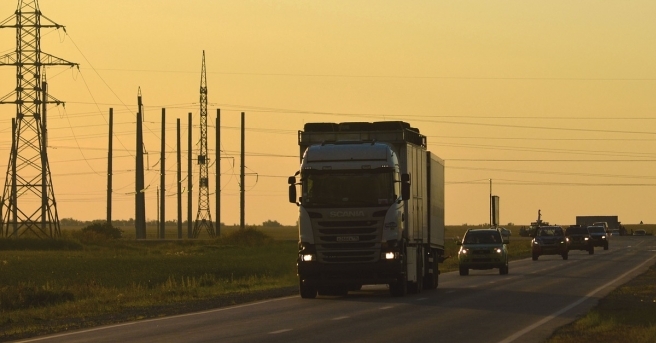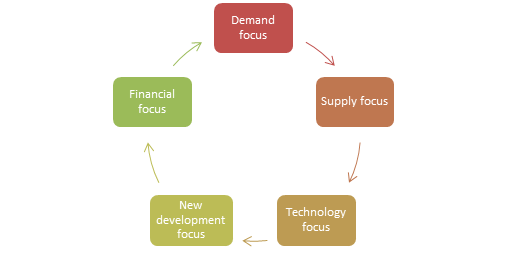Navigating the road ahead for freight transportation industry in India

December 24, 2021:
India has been battling the COVID-19 virus continuously witnessing two waves as it focused on conducting the vaccination drive with full intensity. The second wave situation was further aggravated, due to the inadequacy of medical infrastructure in the rural areas, smaller towns, and within urban centers too. While the country is getting back to business in many states, the impact of COVID-19 has been severe on overall businesses and supply chains in India and globally.
COVID-19 effect on business and supply chains
The effect of coronavirus on global businesses has been devastating. The economic impact of the pandemic is expected to be long-term and bring a permanent change in the way we do business. India too witnessed a complete halt on manufacturing for a brief period with supply chain disruptions and large-scale job loss, reverse migration of the workforce as well as many MSMEs shutting shop.
The supply shock that started in China in February 2020 and the consequent demand shock as global economies shut down, exposed vulnerabilities in supply chains across the world. Further, cross-border trade restrictions accentuated shortages of pharmaceuticals, critical medical supplies, food, and other essential products in various geographies during the peak of the pandemic.
Currently, the business activities globally and in India have started exceeding pre-pandemic levels, indicating a swift recovery from the second wave of COVID-19. The Nomura India Business Resumption Index (NIBRI) in September 2021 crossed the 100-mark. With the business sector achieving new highs and scaling up their operations, the demand for logistics has also skyrocketed, however, there is still an apprehensive sentiment and businesses are trying to take care to buffer themselves to be able to withstand any potential impact for future waves of COVID-19.
With the demand recovery surpassing pre-pandemic levels, the logistics sector managed to recover a big chunk of losses incurred in the first half and closed FY21 with revenue growth of about 4 percent as per an ICRA report. This being an encouraging signal for the Indian economy, the domestic road logistics sector is expected to grow by 6-8 percent in the current financial year.
While this growth is leading to supply and demand imbalances, shipping and logistics costs have also shot up by about 3x since early 2020.
With current, post-pandemic product demand continues unabated, and with optimistic forecasts for greater demand for the second half, concern levels are rising. Reports indicate that retailers are front-loading their holiday inventory procurement activity to try to compensate for global shipping disruptions. This provides added evidence of a significant and accelerating bullwhip effect as businesses attempt to do whatever it takes to secure needed components and finished products.
The response by the Indian Government has been swift in exempting the movement of cargo through ports, supply chains, and the transport of essential commodities from lockdown rules. Airports, though restricted for passengers were fully open for air cargo movement most importantly vaccine and other essentials movement.
Impact on supply chains and how they are changing
The global supply chain industry has witnessed significant disruptions from the pandemic:
- Shippers globally were unable to load and unload on account of lockdowns in various parts of the world in the first phase of the pandemic. This resulted in significant delays in delivery as quarantine timelines needed to be adhered with, in turn creating a significant backlog for goods to be delivered at ports. Further, issues such as availability of labor at ports, customs delays, etc., all of which have added up, causing delivery delays, higher freight rates, inventory build-ups, and demand-supply mismatches globally.
- Container cargo movement restrictions have resulted in the availability of containers shrinking, resulting in a spurt in rates for containers by as much as 3-5x over the last two years.
- As passenger movement stopped or trickled, airlines have focused on increasing their air cargo capacity and have started servicing freight as a priority. However, existing freighters reduced their capacity and frequencies on certain routes leading to higher rates with growing volumes.
Impact on the Indian transportation and trucking industry
The road transport industry was severely impacted in the first phase of the pandemic. Only about 20 percent of about 10 million trucks in India were operational on account of lockdowns restrictions, which meant that the trucking industry which manages above 60 percent of the cargo movements in the country came to an abrupt halt during the first phase of the pandemic.
COVID-19 induced challenges led to a significant disruption of the supply chains and transportation industry in the country. Many small and unorganized players shut shop, laid-off drivers, affecting the overall associated ecosystem. This resulted in further downstream fallouts.
Specific focus areas for the trucking and transportation industry going forward
While the immediate, visible issues have been addressed by the fleet operators by vaccination, providing basic requirements of drivers, labor, and other needs, a mindset to think long term and build on the requirements which would help the disrupted supply chains to heal, and grow are covered under the following categories:

- Demand focus:
• Having a portfolio of customers in all essential and non-essential categories -diversification is a must to
manage industry disruptions
• Focusing on end-to-end services - long-distance, local and hyper-local to cater to all customer needs
• Creating transparency with service providers on demand and supply forecasts - Supply focus
• Service assurance in terms of reliability, consistency, and quality of service
• Developing a base of small fleet owner trucks who are attached on a long-term basis and offered regular loads
• Incentivizing stickiness of fleet & drivers for their operations - Technology focus
• Investing in technology and adopting recognized technology platforms
• Involving customers in the technology adoption strategies and integrating with their systems
• Supporting transport partners in adopting best-in-class and relevant tech solutions along with required training support - New development focus
• Optimization of capacity and spreading of costs across multiple businesses allowing best cost offerings and building capabilities to serve better
• Moving from a regional focus to a national focus
• Embracing best-in-class quality & compliance standards
• Understanding transporter’s demand gaps and offerings opportunities - Financial focus
• Improved cash flows, reduce working capital needs, building long-term financial strength to grow, increase credibility, higher credit ratings
• Offering lower credit periods & timely payment of transporter invoices – shift to an e-documentation & billing with automated payment set-up
• De-risking business for self and transport partners by taking required insurance
Involving third-party credit rating & other business support agencies to help transporters develop robust financial practices
In conclusion
As per IRU (International Road Transportation Union), the road transport and trucking industry have witnessed an extremely difficult period with losses due to the COVID-19 pandemic expected to surpass USD 1 trillion globally. The expectations and the operational procedures for all businesses across industries have been permanently altered because of COVID-19. Transportation businesses, as a result, have also witnessed dynamic changes. The intensity of the changes may not be known for a while, but these changes in working practices are already visible across the industries and would continue going ahead.
Remodeling the global as well as local supply chains in a post-COVID-19 world is essential to meet these changes. There is an increasing need for system upgradation across the entire supply chain, which should include automatic track and trace along with alerts, enhanced navigational abilities, real-time digital tracking, and route optimization, and control tower (command and control center), etc.
The logistics industry involves direct contact between people and goods, making it essential to inculcate technology across all areas in the supply chain. Hence trucking industry needs to focus on technology, new areas of business as well as end-to-end customer servicing to tide over any further disruptions and build a sustainable business model.
The article is co-authored by Rahul Mehta, domain leader for transportation and logistics and Savio Monteiro, senior vice president of transportation and logistics practice at Praxis Global Alliance.
The views and opinions expressed in this article are those of the author and do not necessarily reflect the views of Indian Transport & Logistics News



